
Nellis Air Force Base, Nevada. (April 15, 2025): In this photo by Staff Sergeant Jose Miguel Tamondong, Master Sergeant Trevor Clark, a pararescueman with the 88th Test and Evaluation Squadron leaps from an HH-60W Jolly Green II helicopter during a combat arms demonstration. America has a well-deserved reputation for doing whatever it takes to rescue downed pilots, anywhere at any time.
During World War II, the Japanese ridiculed the Americans for their determination to save downed airmen as another example of Yankee weakness. Philosophically, Japanese culture celebrated ritual suicide rather than surrender and they could not fathom why the U.S. would expend such a heroic effort on a handful of Airmen. Towards the end of the war, they would come to understand why.
There are two main reasons why the U.S. leaves no one behind. First, a pilot undergoes more than a year of expensive training before joining the fleet and becomes even more valuable with each mission. By rescuing these high value assets, the Americans ensured they would retain their hard-won experience for future missions or to train new pilots. The Japanese would discover their error as towards the end of the war their inexperienced aviators were devastated American flyers.
The second, and equally important, reason is morale. Flyers are more willing to risk their lives if they know their command will move heaven and earth to save them. This explains the amazing courage and daring of American pilots versus their poorly trained, inexperienced foe.
America’s military let us every servicemember know that they will never be left behind.


